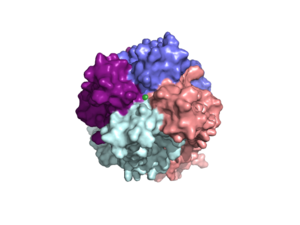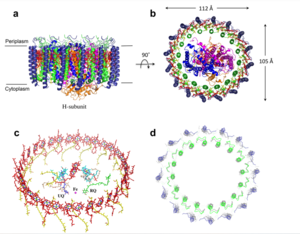This is a default text for your page Elizabeth M. Ratz/Sandbox 1. Click above on edit this page to modify. Be careful with the < and > signs.
You may include any references to papers as in: the use of JSmol in Proteopedia [1] or to the article describing Jmol [2] to the rescue.
Introduction
Calcium is a very important signaling molecule in the body with many physiological functions including muscle contraction, neuron excitability, cell migration and growth. The mitochondria are important regulators of calcium in the body and the calcium uniporter (MCU) maintains calcium homeostasis within the mitochondria. Calcium moves in one direction from the intermembrane space through the inner mitochondrial membrane into the matrix. The matrix is more negative driven by the respiratory chain which draws calcium in and allows calcium to move down its gradient.
The MCU is a complex. Its MICU1 and MICU2 bind together and associate with EMRE which regulates MCU. The MICU1 and MICU2 act as gatekeepers. EMRE connects the MICU1 and MICU2 sensors to MCU therefore regulating calcium uptake for the protein
The selectivity pore is an integral part of the protein. This pore contains a group of glutamate with oxygen facing inward forming a carboxylate ring through which calcium enters. This negative carboxylate ring does a good job of pulling the positive calcium into the selectivity pore at the top of the protein.
Structural highlights and mechanism

Figure 2 Representation of the calcium fitting into the selectivity pore.
The MCU is a dimer of dimers, described as tetrameric truncated pyramid. The uniporter has only a single strong binding site located in the selectivity pore, near the surface of the inner mitochondrial membrane. Activity of the uniporter is dependent on membrane potential and calcium concentration. Calcium from the cytoplasm enters the mitochondrial innermemnrane space through the mitochondrial membrane and is passed to the mitochondrial matrix via the MCU.
Transmembrane Domain
The is located in the , in TM2 (transmembrane 2) while TM 1 (transmembrane 1) surrounds the pore. The transmembrane domain exhibits four fold rotational symmetry. The domain swapping of TM1 of one subunit tightly packing with the TM2 of the neighboring subunits.
Coiled coil
N-terminal Domain
Selectivity Filter
The contains Glu358, Trp354, and Pro359 to allow calcium to pass through the uniporter. The carboxylate oxygen of the side chains draw in the positive calcium ion. The of the carboxyl ring is about 4Å, allowing only a dehydrated Ca ion to bind. Trp38, which is directly next to the Glu residues, stabilizes the carbonyl side chains through and anion pi interactions. These Trp residues also form stacking interactions with Pro359, which orientate the Glu carboxyl side chains towards the middle of the pore to interact with Ca ions.
Calcium Uniporter Structure
[3]
Function
Inhibitors
Disease Links
Types 1 and 2 Diabetes
Pancreatic beta cells circulate insulin through the body. Glucose initiates signals allowing these cells to break down sugar and release insulin, which is all stimulated by mitochondrial energy metabolism. Calcium homeostasis plays a fundamental role in ATP production supplying energy to this process. Defects in homeostasis of calcium like chronic calcium depletion, caused by leaky Ryanodine receptors, causes types 1 and 2 diabetes through failure of this mechanism. Treatment involves targeting the MCU and MICU1 to open the calcium channel and allow more uptake of calcium ions into the mitochondria.
Heart Failure
Calcium overload in the mitochondria of cardiac cells lead to apoptotic cardiac cell death. This large amount of cell death
Relevance
Structural highlights
Student Contributors
This is a sample scene created with SAT to by Group, and another to make of the protein. You can make your own scenes on SAT starting from scratch or loading and editing one of these sample scenes.



